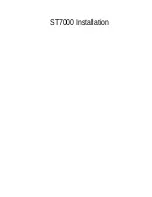
Specifications
Line Voltage: 115-120 or 230-240 V a.c. 50/60 Hz (switchable), 130 VA
Current Draw (no load): 0.21A @ 115-120 V a.c., 60 Hz or 0.10A @ 230-240 V a.c., 50 Hz
Current Draw (maximum load): 0.91A @ 115-120 V a.c., 60 Hz or 0.45A @ 230-240 V a.c., 50 Hz
Secondary Voltage Output: 24 V a.c., 50/60 Hz, 3.0A (85 VA)
Maximum Load Per Station Output: 0.75A (18 VA)
Maximum Load Per Pump/Master Valve Output: 1A (24 VA)
Operating Temperature: -10°C to +60°C (14°F to 140°F)
Storage Temperature: -30°C to +65°C (-22°F to 149°F)
Hardware Features
Plastic or painted stainless-steel cabinetry
Front, back and top locking covers
Modular station output capacity upgradeable in 8-station increments. (48-station maximum when used in conjunction
with TouchNet; 64-station maximum with SitePro.)
Optional output terminal board configurations in 16-station increments
Optional antenna adapter kit available.
Fuses and Circuit Breakers
Power Supply:
1.5A On/Off Switch/Circuit Breaker – Main Power Input
3.2A Fuse – Power Supply (Slow Blow)
4.0A Circuit Breaker – Control Functions
Control Modules:
Pump – 1.0A Fuse (Fast Blow, Automotive Type)
Station Output – 3.0A Fuse (Fast Blow, Automotive Type)
WARNING
IF FUSE REPLACEMENT IS REQUIRED, REPLACE WITH A FUSE OF THE SAME TYPE AND AMPERAGE
RATING. FAILURE TO COMPLY CAN RESULT IN SERIOUS INJURY AND/OR EQUIPMENT DAMAGE DUE
TO FIRE HAZARD.
Electronic Compatibility
Domestic: This equipment generates and uses radio frequency energy and if not installed and used properly, that is,
in strict accordance with the manufacturer’s instructions, may cause interference to radio and television reception. It
has been type tested and found to comply with the limits for a FCC Class B computing device in accordance with the
specifications in Subpart J of Part 15 of FCC Rules, which are designed to provide reasonable protection against such
interference in a residential installation. However, there is no guarantee that interference will not occur in a particular
installation. If this equipment does cause interference to radio or television reception, which can be determined by
turning the equipment off and on, the user is encouraged to try to correct the interference by one or more of the following
measures:
• Reorient the receiving antenna.
• Relocate the irrigation controller with respect to the receiver.
• Move the irrigation controller away from the receiver.
If necessary, the user should consult the dealer or an experienced radio/television technician for additional suggestions.
The user may find the following booklet prepared by the Federal Communications Commission helpful:
“How to Identify and Resolve Radio-TV Interference Problems.” This booklet is available from the U.S. Government
Printing Office, Washington, DC 20402. Stock No. 004-000-00345-4.
International: This is a CSPR 22 Class B product.
© 2018 The Toro Company, Irrigation Business • www.toro.com
Form Number 373-0889 Rev B


























